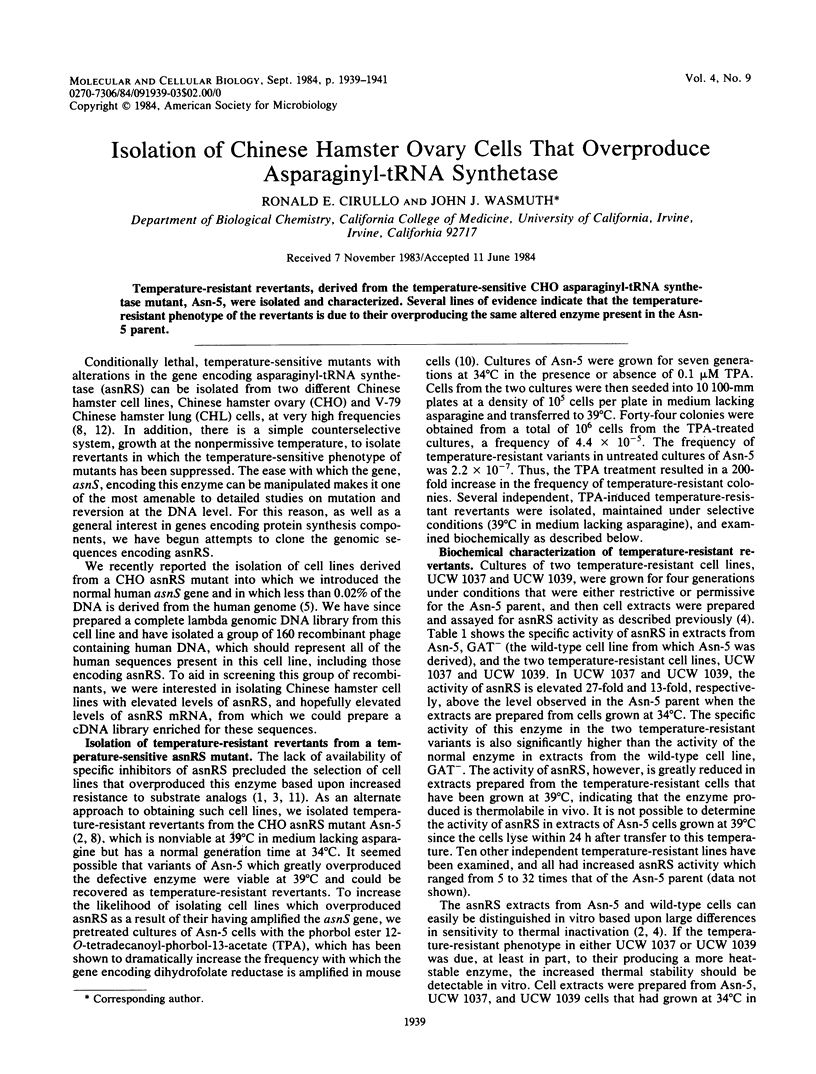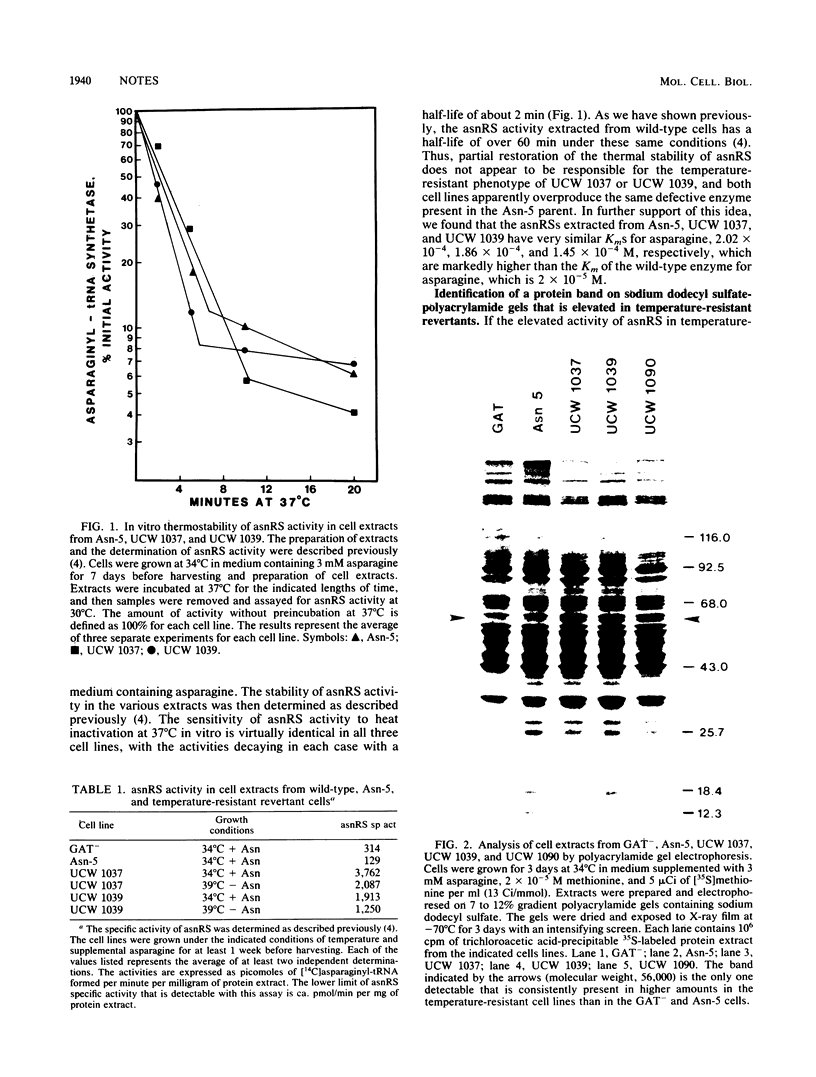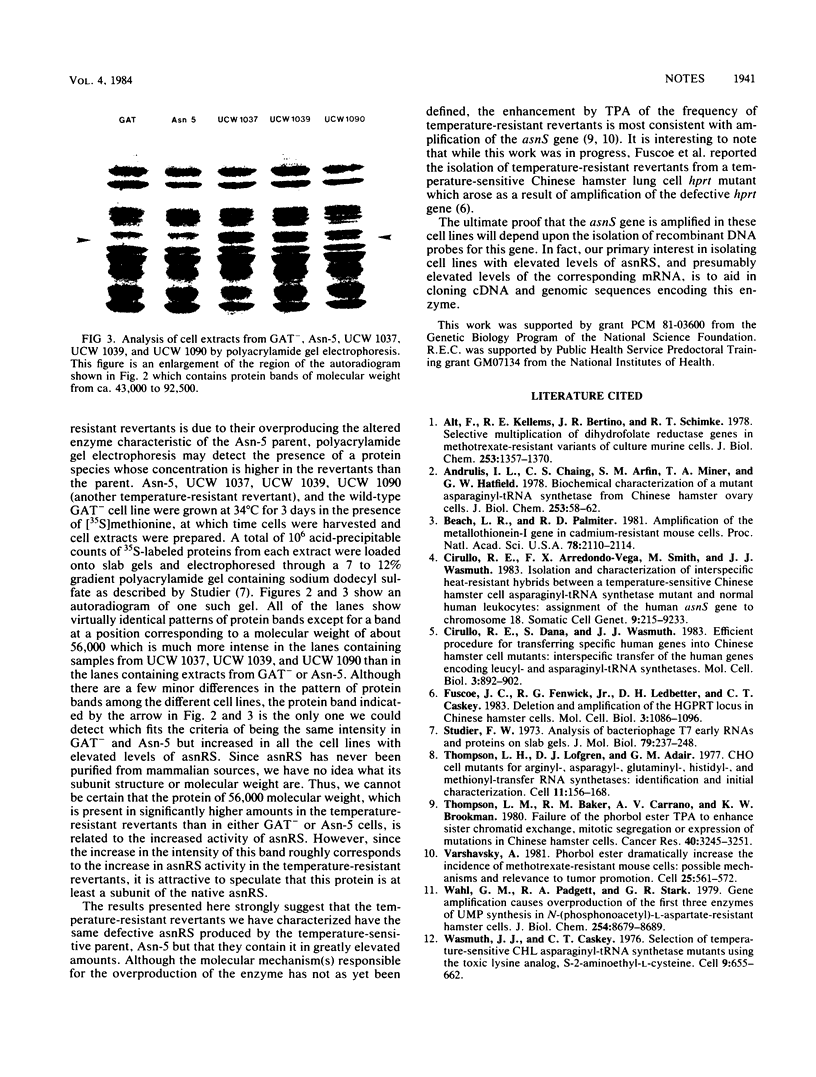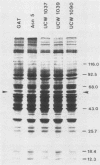Abstract
Temperature-resistant revertants, derived from the temperature-sensitive CHO asparaginyl-tRNA synthetase mutant, Asn-5, were isolated and characterized. Several lines of evidence indicate that the temperature-resistant phenotype of the revertants is due to their overproducing the same altered enzyme present in the Asn-5 parent.
Full text
PDF


Images in this article
Selected References
These references are in PubMed. This may not be the complete list of references from this article.
- Alt F. W., Kellems R. E., Bertino J. R., Schimke R. T. Selective multiplication of dihydrofolate reductase genes in methotrexate-resistant variants of cultured murine cells. J Biol Chem. 1978 Mar 10;253(5):1357–1370. [PubMed] [Google Scholar]
- Andrulis I. L., Chiang C. S., Arfin S. M., Miner T. A., Hatfield G. W. Biochemical characterization of a mutant asparaginyl-tRNA synthetase from Chinese hamster ovary cells. J Biol Chem. 1978 Jan 10;253(1):58–62. [PubMed] [Google Scholar]
- Beach L. R., Palmiter R. D. Amplification of the metallothionein-I gene in cadmium-resistant mouse cells. Proc Natl Acad Sci U S A. 1981 Apr;78(4):2110–2114. doi: 10.1073/pnas.78.4.2110. [DOI] [PMC free article] [PubMed] [Google Scholar]
- Cirullo R. E., Arredondo-Vega F. X., Smith M., Wasmuth J. J. Isolation and characterization of interspecific heat-resistant hybrids between a temperature-sensitive chinese hamster cell asparaginyl-tRNA synthetase mutant and normal human leukocytes: assignment of human asnS gene to chromosome 18. Somatic Cell Genet. 1983 Mar;9(2):215–233. doi: 10.1007/BF01543178. [DOI] [PubMed] [Google Scholar]
- Cirullo R. E., Dana S., Wasmuth J. J. Efficient procedure for transferring specific human genes into Chinese hamster cell mutants: interspecific transfer of the human genes encoding leucyl- and asparaginyl-tRNA synthetases. Mol Cell Biol. 1983 May;3(5):892–902. doi: 10.1128/mcb.3.5.892. [DOI] [PMC free article] [PubMed] [Google Scholar]
- Fuscoe J. C., Fenwick R. G., Jr, Ledbetter D. H., Caskey C. T. Deletion and amplification of the HGPRT locus in Chinese hamster cells. Mol Cell Biol. 1983 Jun;3(6):1086–1096. doi: 10.1128/mcb.3.6.1086. [DOI] [PMC free article] [PubMed] [Google Scholar]
- Studier F. W. Analysis of bacteriophage T7 early RNAs and proteins on slab gels. J Mol Biol. 1973 Sep 15;79(2):237–248. doi: 10.1016/0022-2836(73)90003-x. [DOI] [PubMed] [Google Scholar]
- Thompson L. H., Baker R. M., Carrano A. V., Brookman K. W. Failure of the phorbol ester 12-O-tetradecanoylphorbol-13-acetate to enhance sister chromatid exchange, mitotic segregation, or expression of mutations in Chinese hamster cells. Cancer Res. 1980 Sep;40(9):3245–3251. [PubMed] [Google Scholar]
- Thompson L. H., Lofgren D. J., Adair G. M. CHO cell mutants for arginyl-, asparagyl-, glutaminyl-, histidyl- and methionyl-transfer RNA synthetases: identification and initial characterization. Cell. 1977 May;11(1):157–168. doi: 10.1016/0092-8674(77)90326-9. [DOI] [PubMed] [Google Scholar]
- Varshavsky A. Phorbol ester dramatically increases incidence of methotrexate-resistant mouse cells: possible mechanisms and relevance to tumor promotion. Cell. 1981 Aug;25(2):561–572. doi: 10.1016/0092-8674(81)90074-x. [DOI] [PubMed] [Google Scholar]
- Wahl G. M., Padgett R. A., Stark G. R. Gene amplification causes overproduction of the first three enzymes of UMP synthesis in N-(phosphonacetyl)-L-aspartate-resistant hamster cells. J Biol Chem. 1979 Sep 10;254(17):8679–8689. [PubMed] [Google Scholar]
- Wasmuth J. J., Caskey C. T. Selection of temperature-sensitive CHL asparagyl-tRNA synthetase mutants using the toxic lysine analog, S-2-aminoethyl-L-cysteine. Cell. 1976 Dec;9(4 Pt 2):655–662. doi: 10.1016/0092-8674(76)90129-x. [DOI] [PubMed] [Google Scholar]




